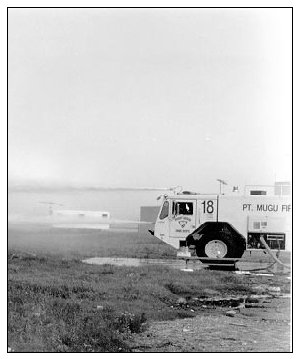| Overview: |
The Aircraft Rescue Fire Fighting
(ARFF) vehicle is currently a main line of defense at shore-based airfield
facilities. These vehicles must be periodically tested, used for training,
and maintained to provide for appropriate operational readiness. The
vehicles use an Aqueous Film Forming Foam (AFFF) for fire suppression.
Despite its wide use and effectiveness for firefighting, AFFF poses an
environmental risk because of its resistance to biodegradation, its
toxicity, and its high Biological Oxygen Demand (BOD) and Chemical Oxygen
Demand (COD). In addition, AFFF has been prohibited for discharge to the
ground and treatment plants at many facilities due to its non-biodegradable
nature, its extreme foaming capacity, and its tendency to upset biological
treatment systems. The combination of these issues has created a conflict
of needs with regard to meeting operational requirements in the protection
of life and property and the stewardship of the environment.
A NoFoam kit has been developed and
demonstrated that replaces AFFF with a benign, biodegradable dye/water
mixture that eliminates the need to release AFFF for operational
maintenance and routine checks. The use of the kit produces a waste stream
that can be assimilated by natural systems or can be treated easily at
treatment plants, thus producing a 100 percent reduction in the problematic AFFF
wastewater stream. (Typically, the amount of AFFF wastewater generated
ranges from 500 to 900 gallons per vehicle per test).
The NoFoam Kit has been demonstrated as a
retrofit to ARFF vehicles models CF4000L (Amertek) and P-19 (Oshkosh). In
the cab of the vehicle, the fire fighter simply pushes and holds a
push-button to activate the kit. The fire fighter then continues through
the normal firefighting discharge procedure. A flow sensor installed in
the kit piping sends electrical signals to the meter in the cab. The
firefighter simply reads the sensor output and quickly determines the
vehicle’s AFFF delivery system performance. By releasing the push-button,
the kit is deactivated and the vehicle is in the ready, firefighting
mission mode.
|
| Compliance Benefit: |
The use of a NoFoam Kit can
help facilities meet material pretreatment standards for discharges of
wastewater into publicly owned treatment works (40 CFR 403) or effluent standards in an
National Pollutant Discharge Elimination System (NPDES) permit (40 CFR 122). In addition, this
treatment process may help facilities meet the requirements of waste
reduction under RCRA (40 CFR 262) and Executive Order 13148.
Under U.S. Naval Fire Protection Program (NAVFAC
Guideline P-1021), tests and training on the
vehicles and structural pumpers are mandated quarterly and annually. In
some cases, based on local airfield requirements, fire chiefs often
conduct daily, weekly, or monthly AFFF system tests in addition to the
mandated requirements. The use of the NoFoam Kit provides an opportunity
to meet or exceed these mandates without environmental
consequence.
The compliance benefits listed here are only
meant to be used as general guidelines and are not meant to be strictly
interpreted. Actual compliance benefits will vary depending on the factors
involved, e.g., the amount of workload
involved.
|
| Materials Compatibility: |
No materials compatibility
issues were identified.
|
| Safety
and Health: |
No safety and health issues
were identified. Consult your local industrial health specialist, your local health and safety personnel,
and the appropriate MSDS prior to implementing this technology.
|
| Benefits: |
- Uses biodegradable and environmentally
benign dye solution or water to test the onboard foam distribution
system.
- Reduces AFFF wastewater normally generated
during firefighting equipment testing, which reduces:
- Groundwater contamination.
- Wastewater treatment plant upsets.
- Hazardous waste management and disposal
requirements.
- Returns quickly to the foam mode after
testing-ready for the fire fighter’s missions.
- Fire Chiefs may perform ARFF vehicle
discharge tests more frequently while staying in environmental
compliance.
- Requires minimal training for firefighters
to operate the kit.
- Equipment is highly cost effective.
|
| Disadvantages: |
None
Identified.
|
| Economic Analysis: |
The NFESC NoFoam Kit is
currently available for ARFF vehicle models CF4000L (Amertek) and P-19
(Oshkosh). The estimated capital cost for each kit is $7,500. The
estimated pay back period is less than two weeks, based on daily foam
distribution system checks. For the purpose of this analysis, one check
consists of eight routine, 5-second system tests (i.e., 5-second
through each nozzles eight times). The minimum pay back period is
estimated at 6 months based on minimal testing frequencies.
Additional cost avoidance savings can be
realized by not using AFFF concentrate in the tests. A 30-second test
consumes approximately 10-20 gallons of AFFF concentrate; thus, a savings
of $70 to $140 per test can be achieved.
Other non-tangible or not readily quantifiable
savings include those realized by elimination of costs associated with
hazardous waste disposal, treatment of the wastewater stream, and/or
downtime of treatment plants due to upsets.
|

